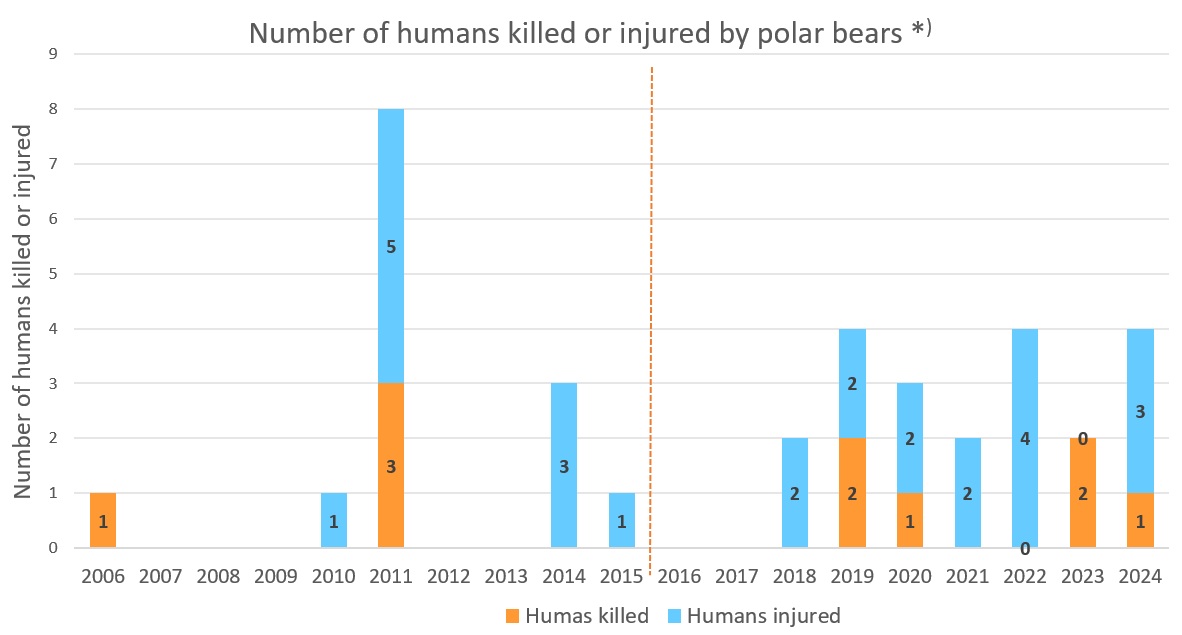First published March 28, 2022. Latest update May 27, 2025.
This page is intended to be updated annually with new data on these metrics (as part of Action HBC-A5 Report findings on human-bear conflicts which end in injury or death (to bears or humans) annually on the Range State website for each country or subpopulation.)
Polar Bears injured or killed in conflict situations
Action HBC-A3, Establish baseline for bear injuries and deaths using existing data from 2020 was created to establish a baseline number of bears injured and killed due to conflicts with humans in order to gauge progress towards meeting Circumpolar Action Plan (CAP) Objective 5. Although a baseline from before the CAP was implemented in 2015 would be the most informative metric for gauging progress, conflict data was not collected in a consistent way among the Range States, and the baseline metric is therefore set to 2020.
In 2020 there were 59 polar bears killed in response to, or to prevent, conflicts with humans (Table 1). In 2021, this number was 63 bears, 89 bears in 2022, 74 bears in 2023 and 64 in 2024. No polar bear injuries were reported in 2020 and 2021, two bear injuries were reported in 2022 and 2023 respectively and one injury was reported in 2024. Bears can be legally killed in defense of human life in Norway, the United States, and Russia. However, in Greenland and Canada bears can also be legally killed in defense of property.
| Table 1. The number of polar bears killed due to conflicts with humans in 2020-2024. Deaths include bears that were killed in response to a conflict or to prevent a conflict | |||||
| Country*) | 2020 (baseline) |
2021 | 2022 | 2023 | 2024 |
| Norway | 3 | 1 | 1 | 2 | 0 |
| Greenland | 5 | 0 | 3 | 1 | 15 |
| United States | 8 | 12 | 18 | 19 | 11**) |
| Canada*) | 41 | 49 | 67 | 51 | 38 |
| Russia | 2 | 1 | 0 | 1 | 0 |
| Total | 59 | 63 | 89 | 74 | 64 |
*) The annual reporting period for Canada is July 1 to June 30. The annual reporting period for other countries follows a calendar year from January 1 to December 31.
**) Reporting is based on best available data as of April 2025. It is subject to change as additional information may be received.
Note: Polar bears can be legally harvested for subsistence by Indigenous people in Canada, Greenland, and the United States. Because polar bear harvest is legal in these countries, bears killed in conflict situations are not always distinguished from bears killed for subsistence purposes. The Range States are continuing to work with their domestic partners to standardize reporting, and numbers will be updated as additional information becomes available.
For the purpose of this summary, we consider a bear to have been killed when there is confirmation that the animal is deceased (i.e., bears that are wounded and the body is never found are considered ‘injured’1). Deaths include bears that were killed in a response to a conflict or to prevent a conflict. Although there were no bears injured in 2020, definitions were created for future reporting periods. Injuries to polar bears are defined as animals that are wounded during conflict situations. Injuries that likely would have resulted in death are also included as injuries, but notation is made where appropriate.
1 Definitions for ‘killed’ and ‘injured’ may differ domestically among the Range States. Therefore, variation in the number of bears killed may differ between domestic and Range States reporting.
Humans injured or killed by polar bears
Action HBC-A4, Establish baseline for human injuries and deaths using existing data from 2006-2015, was created to establish a baseline of human injuries and deaths caused by polar bears and will gauge progress towards meeting CAP Objective 5. Data on human mortalities and injuries from polar bears will continue to be collected over the 10-year lifecycle of the CAP (2015-2025).
The baseline was established using data from the Range States in the decade preceding the CAP. From 2006-15, 4 humans were killed and 10 were injured by polar bears. During this period, humans were killed by polar bears in Norway (n = 1) and Russia (n = 3), while injuries occurred in Norway (n = 6), Canada (n = 3), and Russia (n = 1).
During the first nine years of the CAP (2016–24), 6 people were killed and 15 were injured by polar bears. Deaths occurred in Canada (n = 3), USA (n = 2) and Norway (n = 1), while injuries occurred in Norway (n = 3), Greenland (n = 4), Canada (n = 7), and Russia (n = 1).
 *) The annual reporting period for Canada is July 1 to June 30. The annual reporting period for other countries follows a calendar year from January 1 to December 31.
*) The annual reporting period for Canada is July 1 to June 30. The annual reporting period for other countries follows a calendar year from January 1 to December 31.
Figure 1. The number of humans killed or injured by polar bears in Canada, Greenland, Norway, Russia, and the United States, 2016-24. The dashed line represents the 2015 implementation of the Polar Bear Range States Circumpolar Action plan.
------------------------------------
Disclaimer
The Polar Bear Range States (hereafter, PBRS) seek to ensure that the information published on this website is accurate, and informed by the best information available at the time of publishing. However, due to the unique nature of each interaction between polar bears and people, the PBRS and their employees or agents shall not be held liable for any injury, including death to any person, nor for any property damage or loss, which may be sustained from the use and application of the information published on this website. Any use or reliance on the information published on this website by any individual is at that individual’s sole risk. Polar bears are wild animals that can cause considerable harm and the PBRS assumes no liability with respect to use and application of the information contained herein.
